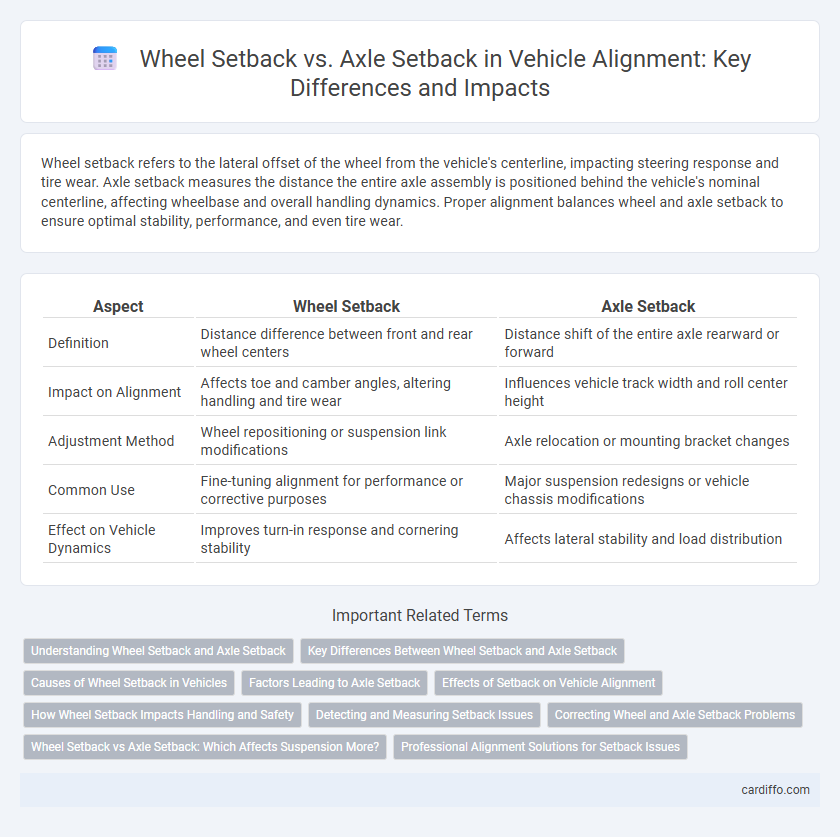Wheel setback refers to the lateral offset of the wheel from the vehicle's centerline, impacting steering response and tire wear. Axle setback measures the distance the entire axle assembly is positioned behind the vehicle's nominal centerline, affecting wheelbase and overall handling dynamics. Proper alignment balances wheel and axle setback to ensure optimal stability, performance, and even tire wear.
Table of Comparison
| Aspect | Wheel Setback | Axle Setback |
|---|---|---|
| Definition | Distance difference between front and rear wheel centers | Distance shift of the entire axle rearward or forward |
| Impact on Alignment | Affects toe and camber angles, altering handling and tire wear | Influences vehicle track width and roll center height |
| Adjustment Method | Wheel repositioning or suspension link modifications | Axle relocation or mounting bracket changes |
| Common Use | Fine-tuning alignment for performance or corrective purposes | Major suspension redesigns or vehicle chassis modifications |
| Effect on Vehicle Dynamics | Improves turn-in response and cornering stability | Affects lateral stability and load distribution |
Understanding Wheel Setback and Axle Setback
Wheel setback refers to the horizontal distance between the wheel centerline and the vehicle's axle centerline, influencing handling and tire wear. Axle setback measures the position of the entire axle relative to the vehicle's frame, affecting suspension geometry and alignment settings. Understanding both wheel setback and axle setback is crucial for precise wheel alignment and optimal vehicle performance.
Key Differences Between Wheel Setback and Axle Setback
Wheel setback refers to the horizontal distance the wheel is positioned behind a reference point on the vehicle's frame or body, affecting the tire's vertical alignment and handling characteristics. Axle setback measures the position of the entire axle relative to the vehicle's centerline or chassis, influencing overall vehicle geometry and suspension dynamics. Key differences include wheel setback's direct impact on tire contact patch and camber angles, while axle setback primarily alters the alignment baseline and steering axis inclination.
Causes of Wheel Setback in Vehicles
Wheel setback occurs when the wheel is positioned behind the true axle centerline, often caused by manufacturing tolerances, suspension component wear, or damage from collisions. Variations in control arm bushings, bent wheel hubs, or improper repairs can shift the wheel's lateral and longitudinal position, leading to alignment issues. Understanding these causes is crucial for accurate wheel alignment and maintaining optimal vehicle handling and tire wear.
Factors Leading to Axle Setback
Axle setback occurs when the axle is positioned behind the center of the wheel, influenced primarily by vehicle design parameters such as suspension geometry and frame structure. Manufacturing tolerances and wear in suspension components also contribute to axle setback by altering the intended alignment. This misalignment can impact steering stability and tire wear, making precise measurement and adjustment critical in automotive wheel alignment.
Effects of Setback on Vehicle Alignment
Wheel setback and axle setback significantly influence vehicle alignment by altering toe, camber, and thrust angles, which directly affect handling and tire wear. Excessive wheel setback can cause uneven tire wear and instability, while axle setback impacts the vehicle's tracking and can induce steering pull. Precise measurement and adjustment of both setbacks are essential to maintain optimal alignment, ensuring safety and extending tire life.
How Wheel Setback Impacts Handling and Safety
Wheel setback, the horizontal distance between the front wheel centerline and the front axle line, directly influences vehicle handling by affecting steering response and vehicle stability during cornering. A greater wheel setback increases the scrub radius, altering the steering feedback and potentially leading to more understeer or oversteer, thereby impacting overall safety. Precise adjustment of wheel setback is crucial for maintaining optimal tire contact, improving traction, and ensuring predictable vehicle behavior under various driving conditions.
Detecting and Measuring Setback Issues
Wheel setback and axle setback are critical parameters in vehicle alignment, affecting handling and tire wear. Detecting setback issues requires precise measurement tools like laser alignment systems and computerized wheel alignment machines to compare wheel and axle positions relative to the vehicle's centerline. Accurate measurement enables technicians to identify misalignment caused by damage or manufacturing tolerances, ensuring corrective adjustments restore proper alignment for optimal vehicle performance.
Correcting Wheel and Axle Setback Problems
Correcting wheel setback and axle setback problems requires precise measurement of the lateral misalignment between the wheels or axles, often using alignment gauges or computerized wheel aligners. Adjustments to the suspension components or repositioning of the axle can restore proper alignment, improving vehicle handling and tire wear. Accurate correction ensures optimal wheel tracking and reduced stress on steering and suspension systems.
Wheel Setback vs Axle Setback: Which Affects Suspension More?
Wheel setback significantly impacts suspension performance by altering the tire's contact patch and affecting handling dynamics, while axle setback mainly shifts the vehicle's weight distribution without directly changing suspension geometry. Precise measurement of wheel setback is crucial for suspension tuning, as even minor deviations can cause uneven tire wear and compromised ride quality. Axle setback influences overall vehicle balance but has less immediate effect on suspension components compared to wheel setback.
Professional Alignment Solutions for Setback Issues
Professional alignment solutions for wheel setback versus axle setback focus on precise measurement and correction techniques tailored to each issue. Wheel setback, where one wheel is positioned differently relative to the other on the same axle, requires adjustment to maintain proper directional control and reduce uneven tire wear. Axle setback, involving the entire axle being shifted forward or backward relative to the vehicle frame, demands specialized alignment tools and procedures to restore optimal vehicle stability and tracking accuracy.
Wheel setback vs Axle setback Infographic

 cardiffo.com
cardiffo.com